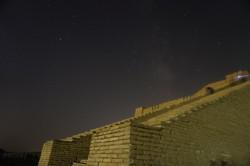Loading...
Related Media
The Pillar of Creation
Caption: Winner in the 2022 IAU OAE Astrophotography Contest, category Still images of celestial patterns.
This image shows the night sky over Tre Cime di Lavaredo, (Dolomites Natural Park), in the region of Veneto, Italy, in October 2021.
The bright spot on the left-hand side is the planet Jupiter, appearing in the constellation Capricorn. To the right of Jupiter and below the two horn stars of Capricorn is the planet Saturn. Just above Jupiter we can see parts of Aquarius, one of the largest constellations and also part of the Zodiac. North of these constellations, left of the Milky Way, there are mostly faint stars. The brighter whitish one in the top left corner is Enif, a binary star in the constellation Pegasus.
The Milky Way seems to emerge from a rock like celestial vapour. Roughly centred in the image are two bright stars left and right of the Milky Way: Altair and Vega, respectively. They seem to be separated by the galactic stream, as told in a popular Chinese folk story where they represent a loving couple. Today, in popular astronomy, the fairly bright star at the upper edge of the photograph is added to form a huge triangle with them, the Summer Triangle in the northern hemisphere.
Altair is the brightest star of the Babylonian constellation Aquila, the Eagle. In ancient Babylon, it was said that the Eagle was carrying king Etana up in the air so that he could see Earth from above. Next to the Babylonian Eagle was the constellation of the Corpse, that returned only in Roman times when Ptolemy put it below the Eagle as the new sub-constellation “Antinous”. It is seen as the corpse (or soul) of the Roman emperor Hadrian’s favourite who had just died in the Nile.
Vega is the bright white star to the right of the Milky Way. It forms part of the small constellation Lyra, famous for hosting the Ring Nebula, which is an impressive planetary nebula — a dying star blowing its gas into space.
At the right edge of the image, three stars in a bent row appear rather prominently. This is the handle of the Big Dipper pointing downwards to a bright star close to the horizon: Arcturus, the bright star of the constellation Bootes (Greek: the Ploughman). This kite-like constellation is probably a pagan interpretation of the Babylonian god “Enlil” whose constellation also occupied that place in the sky. The Romans re-interpreted this figure as The Ox-Driver who controlled the Seven Oxen seen in the bright stars of Ursa Major.
Directly right of Vega, there is the huge constellation Hercules and below it, directly to the left of Bootes, we find a half-circle of stars comprising the small constellation Corona Borealis, associated with Ariadne, daughter of King Minos of Crete in Greek culture.
The lights seen in the bottom left side of the image are due to the reflection of artificial lights in the clouds.
Credit: Giorgia Hofer/IAU OAE
Credit: Giorgia Hofer/IAU OAE
License: CC-BY-4.0 Creative Commons نَسب المُصنَّف 4.0 دولي (CC BY 4.0) icons










